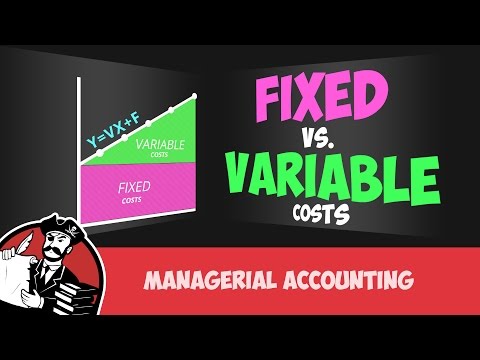6.9: Fixed vs. Variable Costs
- Page ID
- 45853
Learning Outcomes
- Define and give examples of fixed and variable costs
Fixed costs happen, regardless of the manufacturing or sales level. Costs such as rent, property taxes, utilities and administrative wages will need to be paid whether you manufacture one item or thousands of items. They may differ some based on output. For example, if your sales get to a point where you need to add an additional manufacturing facility your rent, property taxes and other fixed costs may rise. During planning and budgeting, it is important to know what your fixed costs are and how they affect the profitability of the company.
Fixed costs can be further identified as:
- Committed fixed costs: These are multiyear organizational investments that cannot be easily changed. Examples of committed fixed costs include investments in assets such as buildings and equipment, real estate taxes, insurance expense and some top-level manager salaries.
- Discretionary fixed costs: These arise from annual decisions by management and could include advertising, research, management development programs or large scale public relations plans. These fixed costs can be cut out with no real damage to the long-term goals of the company.
Variable costs will change depending on how many products you buy or manufacture. For a cost to be considered variable, it needs to vary based on some activity base. An activity base may also be called a cost driver. Units produced, units sold, direct labor hours and machine hours are all possible activity bases or cost drivers in a manufacturing facility. Using units sold as a cost driver, you wouldn’t need to buy raw materials for 1,000 widgets if you only have orders for 500. These costs include direct materials, direct labor and some of the manufacturing overhead items.
Let’s look at a restaurant example. If we serve 100 customers, we will need to purchase food (direct materials) for the 100 meals we serve. So if our cost of goods sold per meal is $4, we would spend $400 on food if we serve 100 meals, but only $200 if we serve 50 meals. This is a variable cost.
Now, whether we serve 100 meals or 10 meals, the cost of the building will remain the same. If rent on our building is $1,000 a month, and we serve 1,000 customers, then our average cost per customer is $1. If we serve 500 customers, then our average cost per customer is $2. The amount paid for rent does not change, but the cost per customer does.
Up to this point, we have been talking primarily about manufacturing businesses. What if we manage a retail store? Walmart and Target also have fixed and variable expenses that are incurred in the operation of their business, as do all other retail outlets, including online stores.
Variable costs are those that will vary depending on the output of the store. In a retail setting, these costs might include sales commissions, inventory purchased for resale, cash register tape and packaging materials such as bags. These costs will all depend on how much product is being sold.
Fixed costs will be similar to those in a manufacturing facility. Administrative wages, rent, property taxes and utilities are all going to be fixed. These will exist whether the retail store sells one item or thousands!
So all business operations will have fixed and variable costs. Regardless of the type of business, these costs need to be evaluated, managed and controlled to create the best net profit for the company.
Practice Questions
- Fixed vs. Variable Costs. Authored by: Freedom Learning Group. Provided by: Lumen Learning. License: CC BY: Attribution
- Fixed and Variable Costs. Authored by: Notepirate. Located at: https://youtu.be/RIYN2F6fW2Y. License: All Rights Reserved. License Terms: Standard YouTube License


